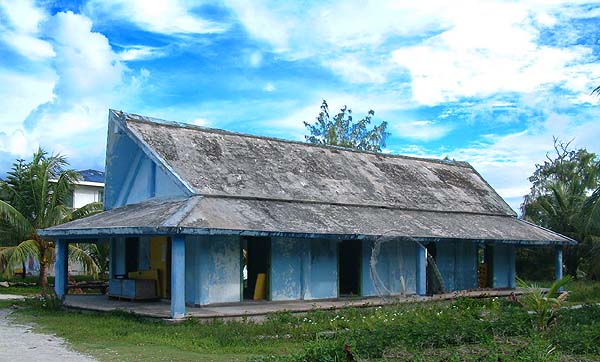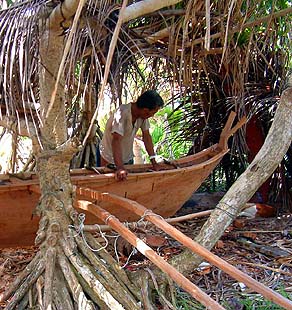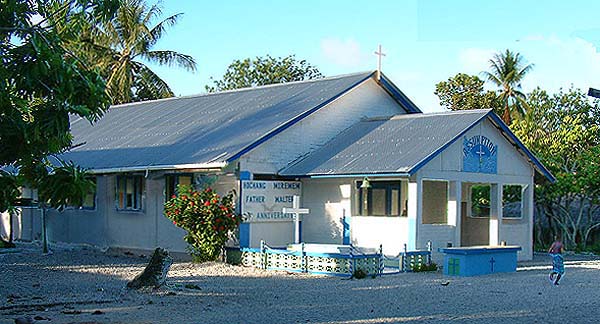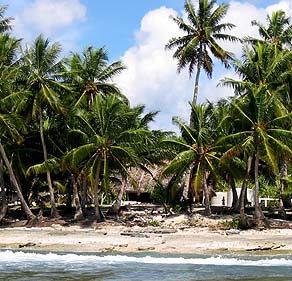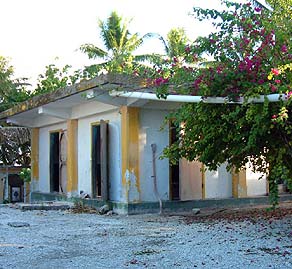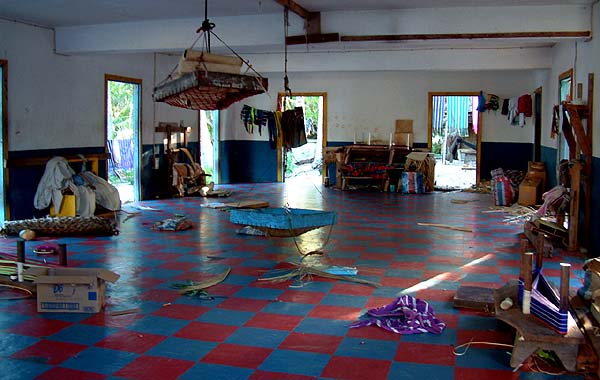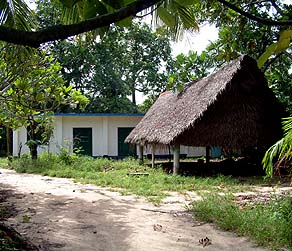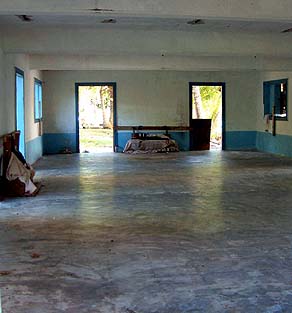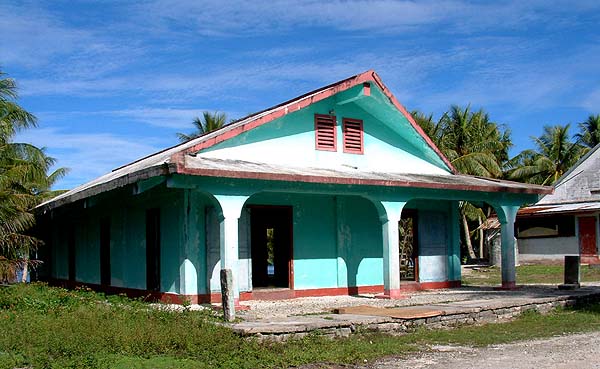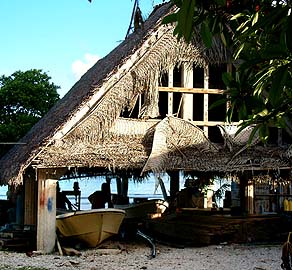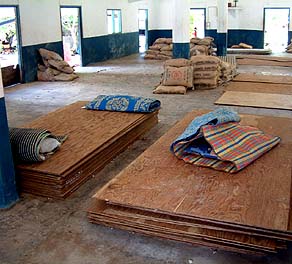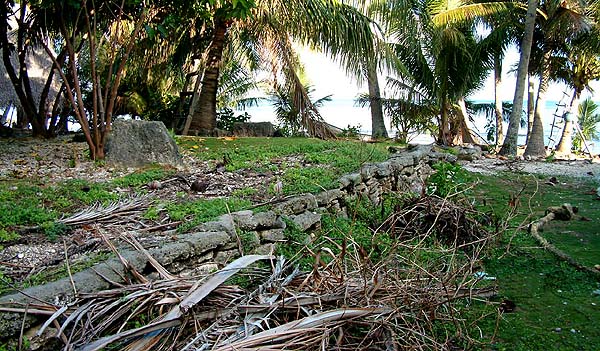 |
 |
 |
|||||
|
|
|
|
|
|
|
|
|
|
|
|||||||
|
Yapooy, one of the two Men's Houses on Falalop.
|
|
“Christianity came, and the many changes came,” Chief Yatch says. “No more taboo things here. While I was young there were certain places that people didn’t go, here on Falalop. Those are superstitious, I believe. They said there was a ghost there that could punish you if you went to that place. No more today."
|
||
|
|
||
“When we were still building canoes, the taboos were in place, Daniel says. "But nowadays, it has to do with the extinction of the canoe and we don’t carve it and build it anymore. So now I’m building this one here, and anybody can just come around." On the Beaches page, several taboos were explaining regarding when and when a canoe could be built. Barney pointed out that “When you build a new canoe, you cannot make it in the village. You have to go to the end of island.” “No, it’s not being practiced anymore,” Daniel says. “You see this building, this canoe right beside my house. But this old one over here, I built it outside of the village. In fact, on the other side of the island. When it was finished, then we just put it in the water and moved it, like we used to do.”
|
|
|
“The church says ‘you do this’ and ‘you don’t do that as Christians,” Juanito remarks. “And we kind of make up some other things that we ‘don’t do.’ Maybe this we cannot do because it’s against church policy. So we stop doing such things. But when we look at them, we think they’re not really that bad. They are part of our culture we grew up with, and there are some things that we cannot just ignore. “One thing that the church says is ‘the fish don’t listen to magic.’ The magician, okay. You can go and put the magician, no problem. Only the magic part, the belief that magic will make things happen. It’s the one that we don’t encourage that’."
|
|
|
|
|
"The priests were quick, they were smart: the first people they converted were the high chiefs. They talked to the chiefs and the chiefs starting taking out some of the taboos, saying how the men, when they pass the women’s house, they don’t talk to the women. The women don’t call them. Nothing comes from the women’s house that goes to these older people, especially the chief. Those things, really do not do anything.”
|
||
|
|
||
“See, we have a men’s club. They have a woman’s club," Chief Yatch adds. "When women were in their clubs, we males were not supposed to go there. That’s for when they got together, you’re not supposed to go there, and so this would be ladies, they never go to men’s house. That’s still going on now. That’s part of the culture. " “So when we built the concrete church," Juanito concludes, "even the young ladies that stay at the Women’s House, they came up and mixed water for the workers and they even helped lay rocks. These now-become-older ladies of the island, they’re the ones that did the making the blocks and even helped putting up the blocks. Not only this church here, but all the churches in Ulithi. The priest took them and they went around and worked, and we saw that nothing happens to us, no typhoon came because the women at the Women’s House came up and helped.”
|
|
|
|
“You see our Woman’s House?” Stanley asks. “We complained because the Woman’s House is not supposed to be poured concrete, not a fixed structure; that’s based on the culture. It’s not supposed to be that way. "But our local politicians all wave talk and all that and they changed the minds, maybe they hypnotized our old men, the chiefs, and well, some believe, they agree. ‘Oh, maybe that’s true. See, it’s strong. In case when the typhoon comes and it’s late that we remove the woman from there, now they will be safe.'"
|
|
|
|
|
"But the problem is, if we disagree with women about what they do, according to custom on the island, the mtaang will order all the men, ‘you put rope over there on that Women’s House and then all the men line up on the rope and lets pull so we can put the Woman’s House down right away.’ That’s a punishment that we men are entitled to do—just pull the entire Woman’s House down on the island." “Just to show them,” Mariano adds, “because these men are the very same ones who are going to go back and build the new one again.
|
||
|
|
||
|
“The men build the new one,“ Stanley agrees. “We just pull it down for a few days, so they will kind of bow down, and go ‘oh, now we’re in trouble!’ and all that. So they should behave. But this is ordered by the chief, so it’s no problem. Customarily, we have to do that. And then we already arrange things so that in no time, a new one stands, because it’s not going to be a big one. It’s going to be just a small local-style house. So that’s the difference. “And so now, how can we do that? It’s concrete—you’ll break the rope. We’ve been talking about this. What if we have some kind of conflict between us and the women? And if we try to show them the responsibility that men have over them, and that’s a big point, whether we should just pull that Women’s House down. How can we do that?”
|
“Here, a long time ago, we had two Women’s Houses,” Hosey says, “one here and one at the end of the island. Now maybe there are fewer people, so that they fit into this one. So that one on the other end is no more. And there are still some ladies now that go down and stay at this one while they’re having their period. Even the married ones. "But nowadays most women, when they have their period, they don’t go down to the Women’s House. They just stick around in the village. That’s against one of our taboos. A long time ago, if somebody had her period and never went down to the Women’s House, they punished the family." “There are not really many ladies going down there,” Juanito agrees, “so we know that a lot of them are still having their periods, but maybe two, three months, and no one goes to the women’s house.”
|
|
|
|
|
|
“With the first introduction of the hand-held radios, walkie-talkies, a practice started up,” Chief Taithau says. “Before you left your island, you would contact the next island. But the older people, they stopped that. You had to come to the island and send somebody over to the Men’s House to report the purpose of your trip. “Nowadays, it’s quite different because, aside from the dance practice, some of these, some things are performed in the Men’s House which were not supposed to happen in the Men’s House. The younger boys are bringing in all these musical instruments and they play there.” “There were places for different chiefs to sit, in the Men’s House,” Chief Yatch says. “I think from Yap, all the way to Satawal, we all have that culture. Each chief has their place to sit. But nowadays it doesn’t matter. Just go and sit anywhere you want. It’s dying now, that custom is dying nowadays."
|
||
|
|
||
“When I was young, the Men’s House was very different from how it is now,” Ignathius remarks. “It was thatched roof, and the posts of these coconut trees, they cut it, but now they use plywood and two by four and tin roofs. Not many people go there any more. I think they are busy doing other things. And now we have the schools, so the teachers and the students go there. So that makes really few people go down there at the Men’s House.” “Now, just look at the Men’s House,” Juanito laments. “Nothing but all these materials and cement. Before, these things would never come into this place. But now, instead of people coming here in the morning, they come to the canoe house, and that’s where we plan what to do. We use the Men’s House as a storage place."
|
|
|
“Now even kids are coming in here and playing, but before, they didn’t allow them to even come in here. They just sat outside. And they never came on the walkway on the Rool’ong side of the Men’s House. Kids and ladies didn’t go there. “Nowadays, sometimes people meet in the Men’s House,” Philip says, “and the young people will ask questions and make suggestions. On Mogmog, the custom is still very strong, but it has changed so much since I was young. Now some people talk in the Men’s House."
|
"But in the Men’s House, nobody talks. You just listen to that man from Faaelmey or from Legfaeliuy, those highest clans. They will talk to the people, and we just listen, listen, listen and then do. You don’t ask questions. But now there is a meeting and we discuss this and we discuss that, and ‘oh, we don’t like this, and we like that.’ This never happened before.” “We tried to build the Falsew Men’s House sometime in the nineties,” William Yaad says, “but we could not: at this time, people were used to working for money. This modern style, that’s why we get a problem, but before, no need for money, so when the chief says we do this, we do. But now, when there is no money, nobody shows up. No beer, nobody will show up.”
|
|
|
|
|
|
“Rool’oang is still a taboo place,” Philip points out. “Kids are not allowed to go across it, but this Men’s House on Mogmog, that nobody speaks in that house, children come inside and play, run around, they were not being done before. When I was young, I could not do that because I would be severely punished." “The women and the small kids still don’t go on the Rool’oang platform,” Juanito states. “But before, only certain people went in there and cut up the fish to give five to the high clans, and they’re the ones that have to go there, they have business to do. Nobody else could go there. “Now everybody goes in and helps, because we feel that the more people that work, the faster the work will be done. When they get turtle, they just kill the turtle and bring it up here and everybody comes in and cuts it up. And so that they can get the turtle finished and divided up. Only men, however. No women, no children.”
|
||
|
|
||
| “A lot of
the old taboos are gone,” Juanito concludes.
“I don’t think that any are left now. Things are changing,
without our knowing that we ourselves, we are changing these things.” With these thoughts, we turn to depart Ulithi.
|
||
|
|
||
|
|
|
|
|
|

|
| Ulithi Home | Map Library | Site Map | Pacific Worlds Home |
|
|
|
|

|
|
|
||
|
Copyright 2003 Pacific Worlds & Associates • Usage Policy • Webmaster |
